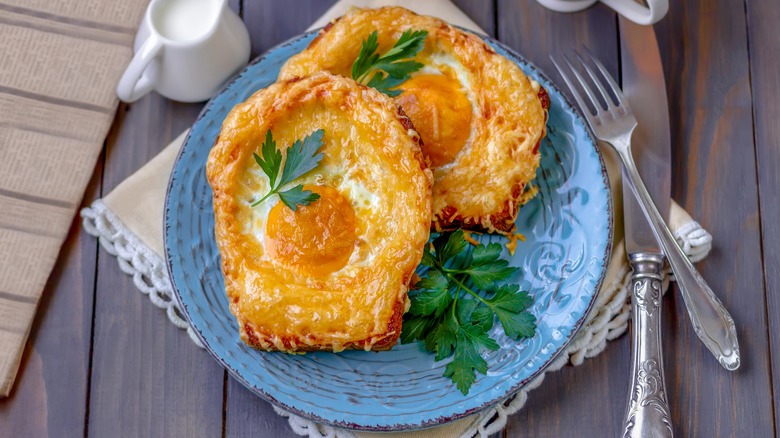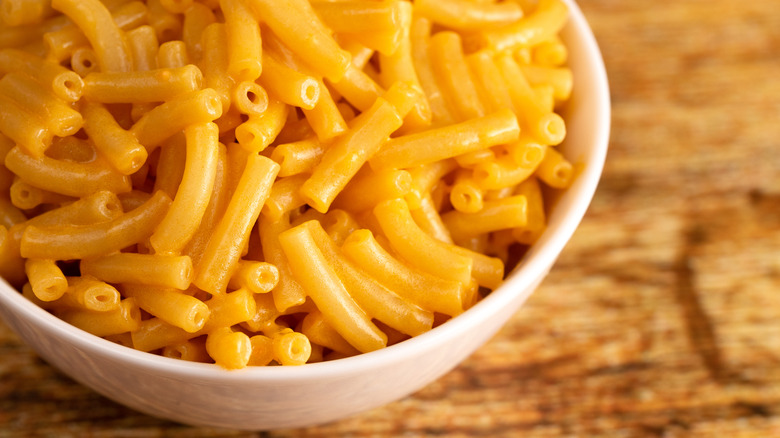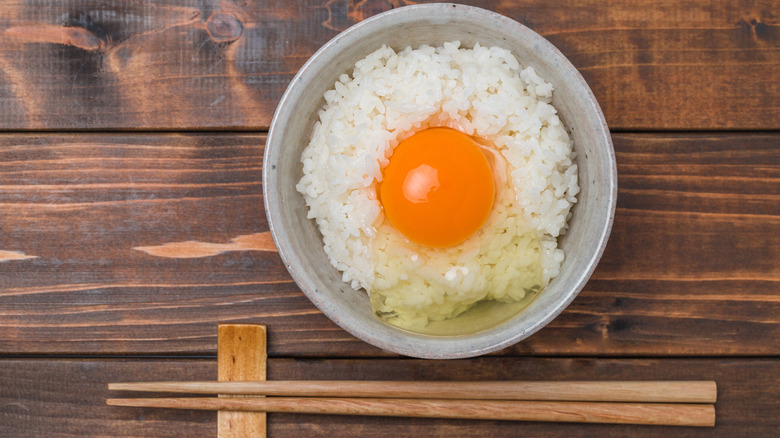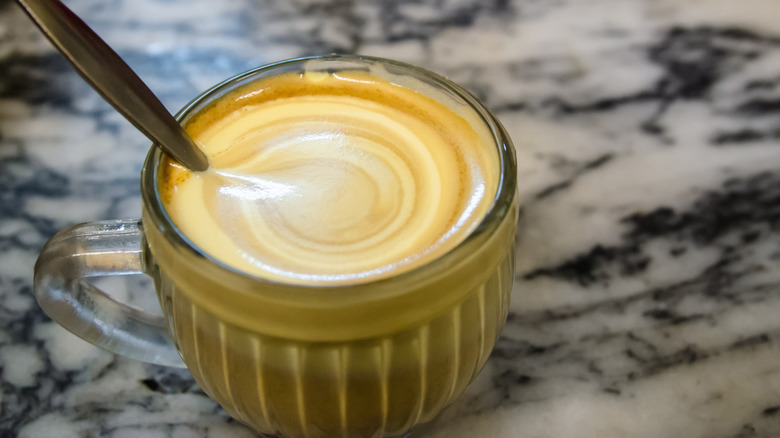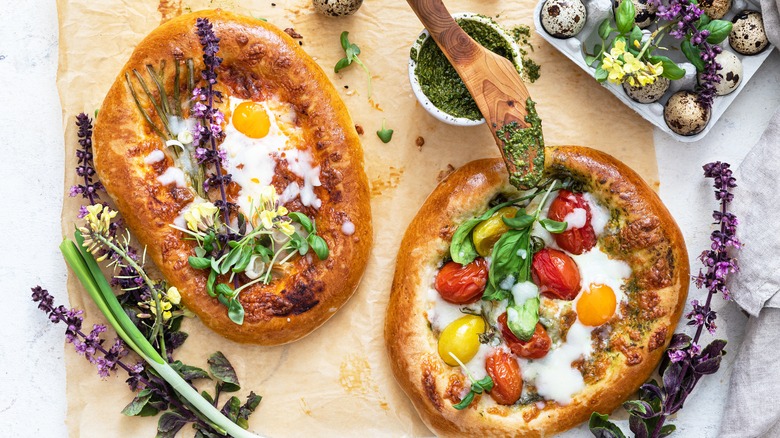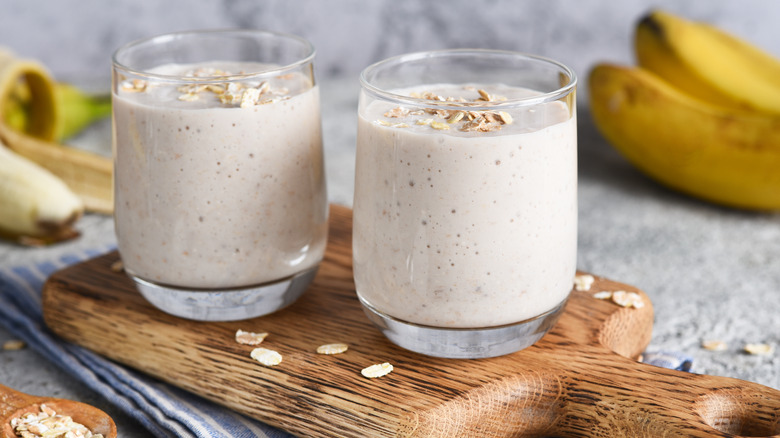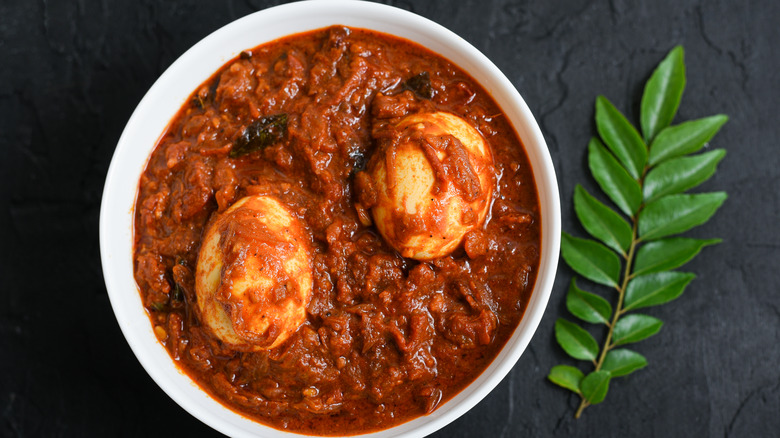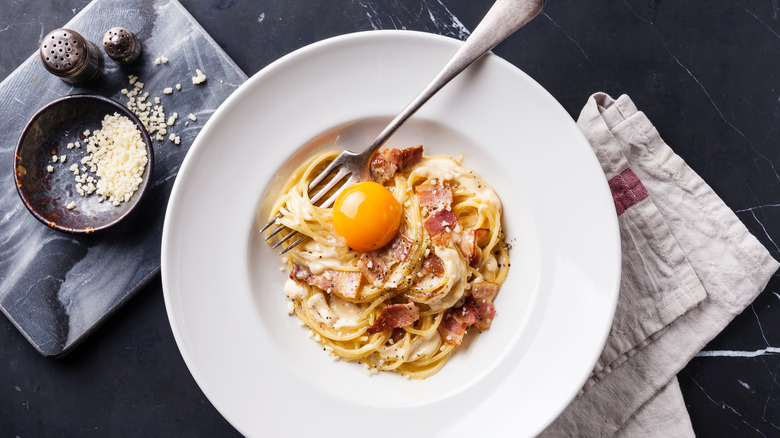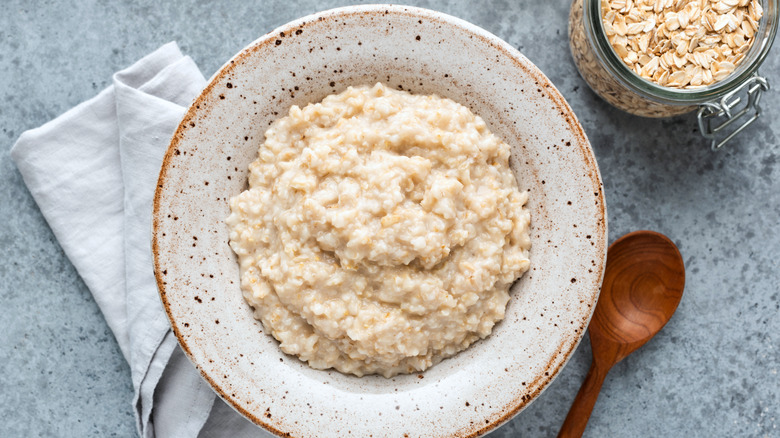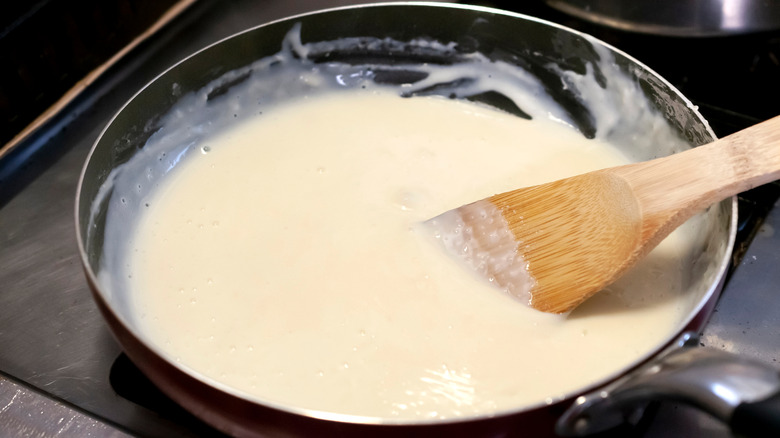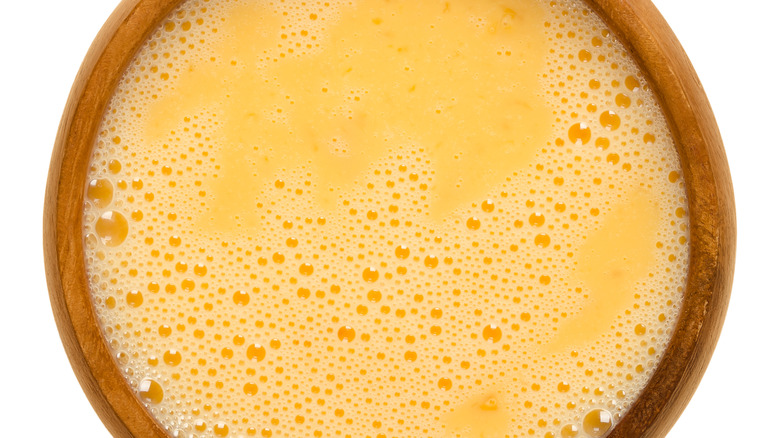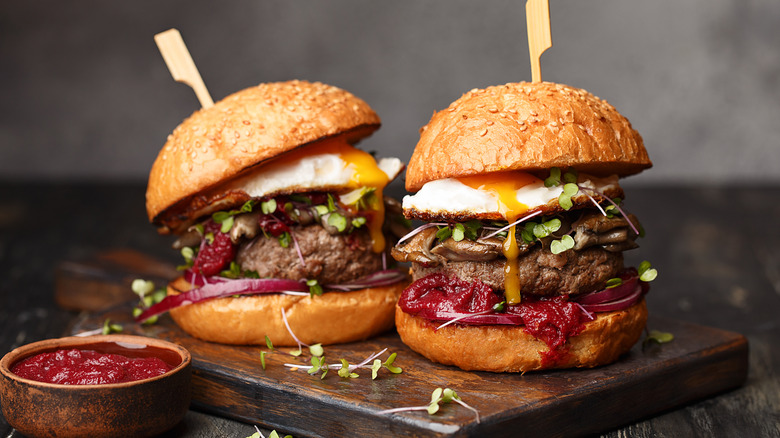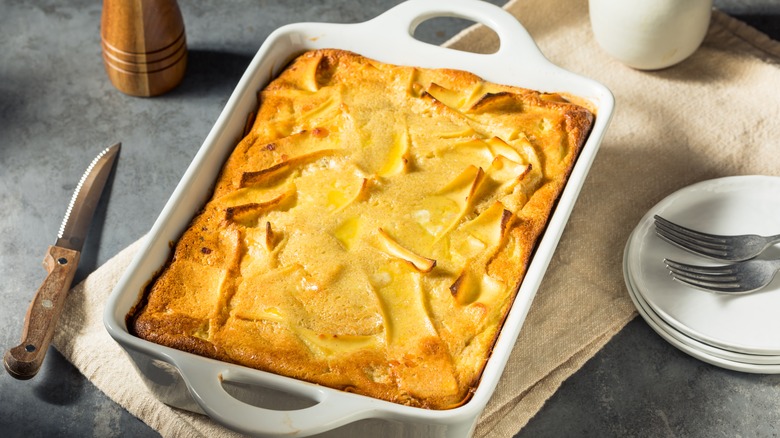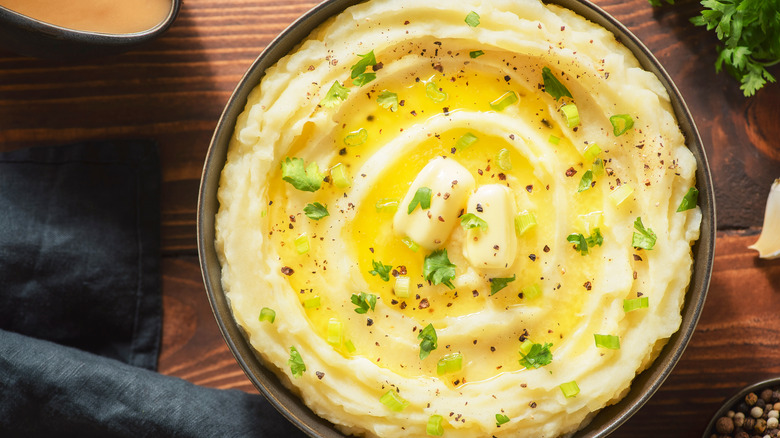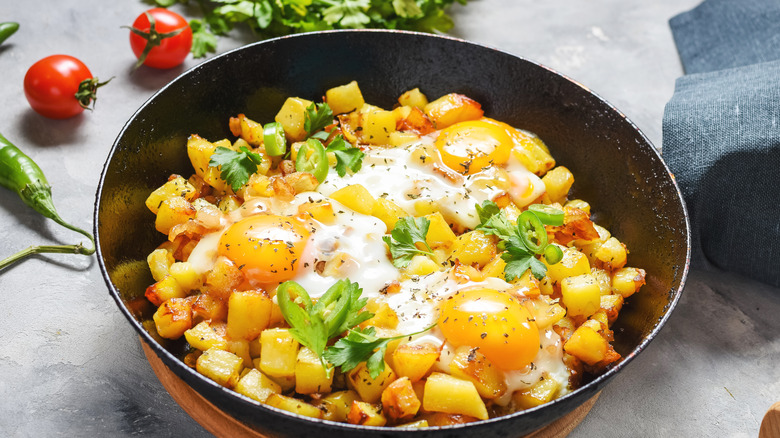Crack A Raw Egg Into These Foods For A Quick And Tasty Upgrade
In the words of food writer Michael Ruhlman, the egg is a "wonder food, a miracle of nutrition, deliciousness, economy and utility." In his essay "Please Consider the Egg," Ruhlman goes on to describe the ingredient as "a singularity with a thousand ends."
We'd have to agree with Ruhlman, a James Beard-winning author who published an entire book on the topic. From souffles and whiskey sours to meringue and brioche bread, the egg is a crucial component for many of the culinary world's finest delights. But you don't have to be a pastry chef or a professional saucier to maximize the power of the egg in your home cooking. Whether you're hoping to harness this food's nutritional benefits or transmute texture from one-dimensional to custardy, there are plenty of recipes where the simple addition of a raw egg can transform your meal.
Read on for tips on how to upgrade everything from curry and oatmeal to a basic pan sauce. And as a general disclaimer, we recommend using only pasteurized eggs for these recipes and proceeding at your own discretion with the knowledge that there's an innate risk that comes with consuming any raw product.
Boxed mac and cheese
Boxed macaroni and cheese is a comfort food known for its convenience and startlingly orange hue, but the thin, watery texture of the cheese sauce leaves much to be desired. Adding a raw egg into the mix at the right time, though, can profoundly transform the texture of your cheese sauce from scant to scrumptious.
The process is straightforward enough: crack an egg (or just an egg yolk) into the pot right after you've added the cheese powder to the cooked noodles. Then, stir vigorously along with your liquid of choice until all traces of both egg and powder vanish into the noodles. The result? A sauce that's silky, glossy, and custard-like.
This concept should be familiar to anyone who's ever made carbonara, an Italian pasta dish with a sauce made of pasta water, egg, parmesan, salt, and pepper. Want to level up this dish even more? Save your pasta water and incorporate it as part of the liquid you add alongside the cheese powder. The starchy, binding power of the pasta water will enhance the coating of the cheese sauce, and in the words of Rachel Ray, "wrap the sauce that you've prepared so they're literally married together."
Fresh rice
Take a page out of a Japanese cookbook and elevate a bowl of freshly cooked, steaming hot rice with the addition of a raw egg. It couldn't be easier to replicate this dish, which is known as Tamago Kake Gohan or Japanese egg rice. To start, just scoop out a cup of rice into a bowl, and while it's still hot — that's a very important detail — crack the egg directly into it. If you want to, you can carve out a small well for the egg, but it's not strictly necessary. Then stir the egg vigorously with chopsticks (or a fork) until the eggs are fully beaten and the mixture becomes slippery and frothy.
To amp up the flavor, add a few dashes of soy sauce, MSG, nori, or any other seasoning that can provide a punch of salty, savory flavor. If you're a fan of spice, sriracha or chili crisp would also work great.
Coffee
We know everyone won't be on board with this suggestion, but have you ever considered cracking an egg into your coffee? In the Swedish tradition, it's common to mix an egg (sometimes shell and all) with coffee grounds and boil that concoction in water to create a unique persuasion of this caffeinated beverage.
Fans of this method swear that it reduces the more bitter and acrid notes found in most coffee, while the binding agents in the egg encourage the grounds to clump together rather than attach to the brewed drink. To give it a go, prepare coffee with a French press or in a saucepan, boiling the egg, grounds, and water for about five minutes. Finish the batch in cold water and then either strain or press it for your most velvety cup of joe yet.
The Vietnamese also make a sweeter, more decadent version of this drink with a flavor reminiscent of tiramisu. To replicate at home, blend an egg yolk and condensed milk until frothy. Then top your coffee with the mixture — and maybe a little cocoa powder, if you've got it on hand.
Pizza
We've got two words for you: egg pizza. If you've ever been to France, you'll know that finishing a broiling-hot pizza with a raw egg is a thing, and for good reason. When executed properly, the egg whites set firmly into the melted cheese and the yolk remains just runny enough to dribble over into the tangy sauce. The result is a creamy, crusty, and addicting creation.
This simple, brilliant move will take your pizza game to the next level — but only if you time it properly. If you're making your pie from scratch, you'll want to bake your pizza for five to eight minutes first, so the crust begins to brown. Then, pull it out, make a few small divots in the cheese topping, gently slide the eggs into said divots, and put the pizza back in the oven. Once the cheese is melted, the crust golden, and the egg whites are set, you're good to go.
This isn't just for homemade pizzas. Feel free to use the same technique for frozen pizzas, flatbreads, or even a savory galette (this heirloom tomato version is a delight). You'll just want to make sure you strike the right balance with your timing so that the egg doesn't end up over or undercooked.
Fruit smoothie
Want to feel like you're in "Rocky" without having to actually gulp down a cup of raw eggs? Try whipping an egg or two into a fruit smoothie, instead. This can work exceptionally well with a banana smoothie that includes a blend of banana, milk, vanilla, egg, and sugar for a sweeter rendition. But since in this context the flavor of the egg doesn't jump out much, you can get away with blending one into whatever smoothie you happen to be making, whether it's heavy with tropical fruit or chock full of green veggies like kale and cucumber.
That being said, the real win in this scenario is in the nutrients department: raw eggs carry plenty of high-quality protein, vitamins, minerals, healthy fats, and antioxidants. Just don't forget that a raw egg will typically give your smoothie a thinner consistency, so you may need to add extra ice cubes or Greek yogurt if you prefer a thicker drink.
Curry
Give your homemade curry a whole new dimension with the inclusion of a few eggs. This technique is a riff on the traditional Dhaba-style egg curry that uses hard boiled eggs. It's especially helpful to lean on when you want a hearty meal but don't have any chicken, shrimp, tofu, or other protein.
To execute this correctly, there are a few strategies to keep in mind. First, your curry can't be too thick as the eggs need liquid to cook in — however, you can always add in additional broth or water if your dish is too thick. Also, your curry needs to be gently boiling when you drop in the eggs. And finally, the eggs need to go into the curry one-by-one, and with enough space for them to cook without merging with each other. Once the eggs make it into the pot, cover for about five minutes to cook all the way through.
This approach also works well with jjigae, a popular Korean stew, and any other brothy, spicy dish. The best part of this technique? Eating your meal feels a little like an Easter egg hunt ... you never know when you're going to find an eggy morsel.
Any freshly cooked pasta
The boxed macaroni and cheese concept we discussed above — i.e., using eggs to transform the sauce — can be applied to any basic pasta dish. The important thing is that the noodles are hot and fresh, as the residual heat plays an important role in cooking the eggs and setting the sauce. You'd also be wise to get your egg to room temperature before mixing it into the noodles — see this hack to bring eggs to room temperature quickly. This technique helps ensure the sauce doesn't get clumpy. Finally, make sure your pot of noodles is off the stove before incorporating eggs, lest you end up with scrambled eggs instead of a creamy pasta sauce.
Once you've whisked in the egg, along with that pasta water you were clever enough to save, there are plenty of ways to continue building flavor in the dish. Try miso, anchovy paste, or parmesan for a kick of umami. Brighten things up with a hit of lemon zest or vinegar. Finish with a smattering of just-cracked black pepper, fresh herbs, or flaky salt (or all three!).
Oatmeal
Turn your mushy, morning oatmeal into a more filling, custardy version of itself with the inclusion of an egg. Just like the Japanese egg rice, you'll want to crack an egg straight into the oats as soon as they're done cooking. Then, stir vigorously for a few minutes until your oats become creamy and fluffy. Just be sure the heat is at a bare simmer (or entirely off) during this step, as you want to avoid the eggs scrambling.
From there, the world is your oyster. Take your bowl of oats in a sweet direction with a combination of ingredients such as honey, maple syrup, cinnamon, or cocoa powder. Cook in fruits or veggies — bananas, pears, pumpkin puree, and grated zucchini are a few solid choices. Or go savory with rich spices like turmeric, garlic powder, or ginger. And we always recommend topping things off with crunchy nuts or seeds for a pleasant juxtaposition of textures.
Upgrade your sauce
An egg yolk is a powerhouse ingredient when it comes to sauces, adding both thickness and richness into the mix. What drives this transformation is the protein in the egg, which becomes more viscous as it's heated.
In the case of white sauce, which traditionally leans on a combination of flour, fat, and milk, the yolk's natural binding ability can help keep the sauce from breaking. Plus, the egg's emulsifying powers can persuade everything from bechamel to alfredo sauce to take on a smoother, creamier, and overall more flawless consistency.
But white sauce isn't the only thing that turns (metaphorically) gold from an egg yolk's touch. It can transform any brothy scenario into a more luxurious version of itself. That includes soup, stew, curry, pan sauce, pot likker, and other braising liquids. As usual, the trick is to whisk the yolk (or yolks) slowly over low heat to avoid that dreaded scramble. It may just be the easiest sauce you've ever made.
Or simply use the egg as dipping sauce
In the Japanese hotpot dish sukiyaki, it's common to serve a steaming hot, brothy bowl of thinly sliced meat and vegetables with a small bowl of raw, beaten eggs. The mixture serves as a dipping sauce for the cooked contents of the soup. This might seem unusual to those who haven't tried it before, but many hotpot fans swear that it's essential to the experience, and that the residual heat from the food ends up slightly cooking, and creaming, the egg.
Egg yolk also serves as a sauce in dishes like steak tartare or occasionally as a salad topping. Admittedly, sukiyaki and tartare are highly specific dishes that you wouldn't ordinarily make at home, but that doesn't mean you can't apply the concepts from these dishes to simpler recipes. For instance, it could be delightful to dip thin slices of seared steak into egg — or to introduce an egg dipping sauce to other brothy meat dishes like pho or beef udon. When you really think about it, raw eggs are not so different from mayonnaise, after all.
Burgers
Eggs can seriously amp up the quality of a burger, whether it's a classic beef handheld or a black bean patty. As we've discussed, eggs have a variety of special powers, from emulsifying and enriching to thickening and aerating. In the case of the burger, the egg's role as a binding agent can help keep together a burger that may otherwise crumble or fall apart while cooking.
While this step shouldn't be necessary for beef that has a decent amount of fat, it proves essential for leaner cuts of meat like venison or turkey, as well as plant-based burgers that rely on vegetables or legumes. A raw egg may also come in handy if you're mixing in drier ingredients to your patty, such as fried crispy onions or cheddar cheese.
If you're more of a patty purist who turns their nose at the idea of adding an egg to your burger mix, you could also follow Ruhlman's advice and "put a raw yolk on a hamburger," after it's cooked, a move which he says "flavors and enriches the beef."
Casserole
Most casseroles are practically begging for an egg or two — and not just those of the breakfast variety. A perfect case study of this concept is the iconic Jewish noodle kugel dish, which can easily exceed half a dozen eggs in its construction. Though that might seem egg-sessive (sorry, we've been fighting back egg puns this whole article), the kugel maestros among us are onto something: the inclusion of so many eggs enriches, binds, and brings a soufflé-like loft to the often sweet, sometimes savory baked noodle dish.
So next time you're whipping up a classic casserole, instead of reaching for the heavy cream — or another can of that dreaded (it had to be said) cream of mushroom, chicken, or celery soup — bring a lighter, fluffier dimension to your next broccoli chicken casserole. And uh, hey, not to beat a dead horse, but you should definitely mix an egg into your baked mac and cheese, too.
Mashed potatoes
We're all in search of that creamy, dreamy, perfect mashed potato recipe. Some rely on buttermilk or heavy cream as their personal old faithful — others swear by the baking soda hack or the addition of mayonnaise. Ultimately, the perfect mashed potato is different for everyone. But maybe, just maybe, egg yolk mashed potatoes could be your shining star. If it makes a difference, Stanley Tucci and his wife Felicity Blunt swear by them in their joint-published "The Tucci Cookbook."
Here's how to do it: the next time you're mashing up a few pounds of potatoes, add in your usual butter and milk, then quickly begin stirring an egg yolk into the mixture (careful to not let it scramble). Since egg is a natural emulsifier, it will help create an exceptionally smooth mash, a richer, loftier texture, and a sweet golden-colored hue. Feel free to increase or reduce the amount of egg based on your personal preference, tasting and seasoning as you go.
Whatever leftovers you're sauteing
Listen, we've all been there. You're starving and there's not much food in the refrigerator, besides a few random odds and ends from meals of yore. So you just end up sautéing a combination of say, leftover rice, cooked vegetables, and protein into a haphazard, hunger-fueled concoction. By the time it's done heating up, you're a bit worried if what you're cooking is actually going to taste decent.
But don't worry, the humble egg is here to save you. There are plenty of different techniques, but our preferred method is to dig out a little well (or a few) in the center, drop in a spot of butter or olive oil, and then crack the egg(s) straight in there, covering until the egg whites have set and the yolk is to your liking. This method breathes fresh life and coherence into anything from potatoes and soup to beans and rice — top with hot sauce for extra zing.
